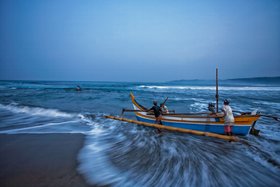Sea level rise and flooding on the north coast of Central Java. Physical causes and social adaptation
Coastal floods and their causes and consequences can be understood as coupled socio-ecological systems.
The pattern of regional sea level rise in Indonesia is highly divergent, showing rates from -5 to more than +10 cm per annum. In Semarang, the capital of Central Java, GNSS-corrected tide gauge data show a strong rise of the local sea level of 10 cm per annum. This rise of the local sea level is mainly caused by land subsidence, which is due to tectonic instabilities,excessive groundwater withdrawal and increased surface load. As a consequence of the subsiding land surface, low-lying urban districts are faced with frequent tidal and river floods. So far, local people in Semarang have been able to cope with these harsh environmental conditions, largely through mutual help, collective action and social capital. Outmigration from affected areas is very limited. But questions remain of whether people will be able to keep up with a possible future increase in the absolute sea level and how long staying in the affected areas will continue to be economically and socially feasible.
The forthcoming article, which is an outcome of the collaboration between the TRANSOCAP and CoRSEA projects of the SPP SeaLevel program, will be soon published at the German journal for Geography Geographische Rundschau:
Bott, L.M., Illigner, J., Marfai, M.A., Schöne, T., Braun, B. (2018): Meeresspiegelanstieg und Überschwemmungen an der Nordküste Zentraljavas – Physische Ursachen und soziale Anpassungsmaßnahmen. Geographische Rundschau 70 (4), S. 4-8.
Moreover, later this summer the paper will be presented to the public during the public lectures of the Geography Society of Cologne (Gesellschaft für Erdkunde zu Köln e.V). The public lecture will be given by Lisa-Michéle Bott, PhD student in the TRANSOCAP project, on 21st June in Cologne.


